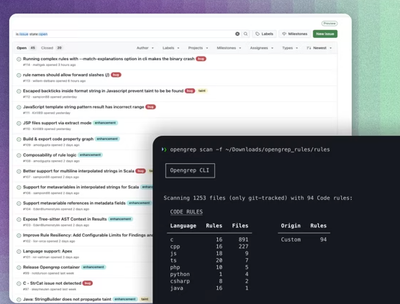
Research
Security News
Lazarus Strikes npm Again with New Wave of Malicious Packages
The Socket Research Team has discovered six new malicious npm packages linked to North Korea’s Lazarus Group, designed to steal credentials and deploy backdoors.
xcomponent
Advanced tools
A cross-domain component toolkit. Useful if you want to build a cross-domain component, which lives in an iframe or popup.
Writing cross domain components is really hard.
Consider this: I own x.com, you own y.com, and I have some functionality I want to put within your page.
I could just give you a javascript component to drop in your page. Javascript components are pretty much a
solved problem at this point! React, Ember, Angular and other frameworks all provide great ways to build reusable and shareable components.
But:
So the obvious choice is an iframe, or a popup. Iframes are great ways to sandbox off little bits of cross-domain functionality, where I want to put a component on your page, but I want it to be a black box and not let you have any access to it. But iframes aren't all that easy to use:
xcomponent aims to solve all of these problems, by providing a clean way to build distributable, cross-domain components that work seamlessly with both iframes and popups. The primary focus of this is to allow you to define your interface, and then do the heavy lifting in the background, and do all of the things you shouldn't need to think about:
Let's say I'm creating a component. First I'd create a spec for the component's interface:
var MyLoginComponent = xcomponent.create({
// The html tag used to render my component
tag: 'my-login-component',
// The url that will be loaded in the iframe or popup, when someone includes my component on their page
url: 'http://www.my-site.com/my-login-component',
// The size of the component on their page
dimensions: {
width: 400,
height: 200
}
// The properties they can (or must) pass down to my component
props: {
prefilledEmail: {
type: 'string',
required: false
},
onLogin: {
type: 'function',
required: true
}
}
});
This spec is the part that's going to be shared between my frame (or popup) and the parent page. It describes how to render the component on the page, what kind of data needs to be passed down, and what kind of callbacks I should expect.
Now I'm ready to set up my component page. Let's start with a simple log-in form. It's written using jQuery, but you can use whatever technology you want - xcomponent is framework agnostic:
<input id="email" type="text" />
<input id="password" type="password" />
<button id="login">Log In</button>
<script>
// Wait for the user to log in
$('#login').on('click', function() {
// Capture their credentials
var email = $('#email').val();
var password = $('#password').val();
// Log them in on the server side
$.post('/api/login', { email: email, password: password }, function() {
console.log('Successfully logged in!');
});
});
</script>
This is great, but at this point it's totally isolated from the parent. If I was to drop this in an iframe, it would function perfectly, but the parent would have no way to interact with it.
Now let's think about how this component is going to be integrated with the parent page. We've already defined the component contract, so we just need to plug it in:
#email element with a prefilledEmail param, if we're passed one.onLogin success callback when we do a successful login, so the parent knows the user has logged in.Let's do that in our example above.
<!-- We should pull in the login component we defined above -->
<script src="./my-login-component.js"></script>
<input id="email" type="text" />
<input id="password" type="password" />
<button id="login">Log In</button>
<script>
// Attach the component definition to our page, which will handle the business logic of the component and call the interface we defined before
var loginComponent = MyLoginComponent.attach({
// When we enter the component, we'll pre-populate the email field if we were passed an email
onEnter: function() {
if (this.props.prefilledEmail) {
$('#email').val(this.props.prefilledEmail);
}
}
});
$('#login').on('click', function() {
var email = $('#email').val();
var password = $('#password').val();
$.post('/api/login', { email: email, password: password }, function() {
// Since we had a successful login, let's call our parent with the callback they provided
loginComponent.props.onLogin(email);
});
});
</script>
As the owner of the component, that's all we needed to do! Now anyone can use the component we defined.
My life is even easier. I just need to drop in your component onto my page:
<!-- We should pull in the login component that was defined above -->
<script src="http://www.my-site.com/components/my-login-component.js"></script>
<!-- Set up a container for the iframe component to live in -->
<div id="container"></div>
<script>
// Create an instance of the component
var mycomponent = MyLoginComponent.init({
prefilledEmail: 'foo@bar.com',
onLogin: function(email) {
console.log('User logged in with email:', email);
}
});
// Render the component to the page
mycomponent.render('#container');
</script>
This is even easier if you're using a supported framework like React, Ember or Angular:
React:
<MyLoginComponent.react prefilledEmail='foo@bar.com' onLogin={this.onLogin} />
Angular:
<my-login-component prefilled-email="foo@bar.com" on-login="onLogin" />
And we're done! Notice how I never had to write any code to create an iframe, or send post messages? That's all taken care of for you.
When you call this.props.onLogin(email); it looks like you're just calling a function, but in reality xcomponent is transparently
turning that callback into a post-message and relaying it to the parent for you.
xcomponent will automatically pass down new properties to the child, depending on the framework you're integrating with.
For example, I might have the following react code:
var Main = window.React.createClass({
componentWillMount: function() {
this.setState({ email: 'foo@bar.com' });
},
emailChange: function(event) {
this.setState({ email: event.target.value });
},
render: function() {
return (
<div>
<MyLoginComponent.react prefilledEmail={this.state.email} />
<input onChange={this.emailChange} placeholder="email" value={this.state.email} />
</div>
);
}
});
ReactDOM.render(<Main />, document.getElementById('example'));
This code updates this.state.email every time the user types into the input field.
Our component can listen for any property updates like so:
<div>
Welcome <span id="email"></span>!
</div>
<script>
MyLoginComponent.attach({
onProps: function() {
if (this.props.email) {
document.getElementById('email').value = this.props.email;
}
}
});
<script>
Note that onProps will be called every time the parent props update, including on first render.
If I wanted to update the props from my parent manually, using javascript, I can do this too:
var login = MyLoginComponent.init({
email: 'foo@bar.com'
});
// At some point in the future
login.updateProps({
email: 'baz@bar.com'
});
If you set a timeout (in ms), xcomponent will automatically call your onTimeout method if the component does not initalize itself in that time. In case no onTimeout methhod is defined it will call the onError method.
var login = MyLoginComponent.init({
onTimeout: function(err) {
// Gracefully handle the timeout during rendering the component
},
onError: function(err) {
// Gracefully handle the error from rendering the component
},
timeout: 5000
});
A lot of the time, it won't make sense to allow people to use your component multiple times in the same page.
To prevent them from doing that, you can set singleton: true when rendering:
var login = MyLoginComponent.init({
singleton: true
});
FAQs
Cross domain components.
The npm package xcomponent receives a total of 828 weekly downloads. As such, xcomponent popularity was classified as not popular.
We found that xcomponent demonstrated a not healthy version release cadence and project activity because the last version was released a year ago. It has 2 open source maintainers collaborating on the project.
Did you know?

Socket for GitHub automatically highlights issues in each pull request and monitors the health of all your open source dependencies. Discover the contents of your packages and block harmful activity before you install or update your dependencies.

Research
Security News
The Socket Research Team has discovered six new malicious npm packages linked to North Korea’s Lazarus Group, designed to steal credentials and deploy backdoors.

Security News
Socket CEO Feross Aboukhadijeh discusses the open web, open source security, and how Socket tackles software supply chain attacks on The Pair Program podcast.

Security News
Opengrep continues building momentum with the alpha release of its Playground tool, demonstrating the project's rapid evolution just two months after its initial launch.